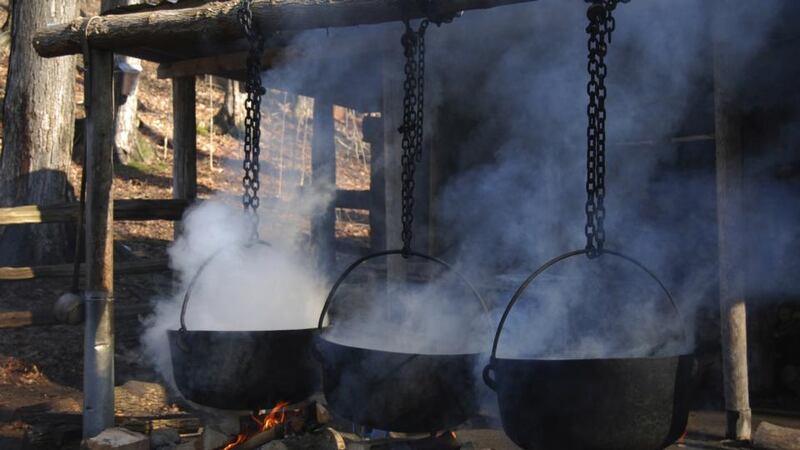The sun is shining, the wind is calm and it’s a pleasant six degrees in Eganville, Ontario. After a long brutally cold winter, spring is almost upon us. Although there is still snow on the ground, the trees are coming out of their dormant state, which means only one thing: it’s maple syrup season.
Here in the valley, where you can’t walk five feet without stumbling into a maple tree, it seems every second person is making syrup at this time of year.
I’ve been in Canada for years but am still in awe at the sight of 100,000 maple trees in the blazing colours of autumn. And when I see the leaves turn in “the Fall”, my thoughts turn to spring, when the sap starts to run.


I’d never tasted maple syrup until I came here. Now, though, on Pancake Tuesday, I no longer make crepes with lemon and sugar. I make thick pancakes and waffles and drown them in syrup.
Maple syrup is to Canadians what tea is to the Irish. When Canada ditched the Union flag in the 1960s and made a new official one, the maple leaf was adopted as a symbol of national unity.
Making syrup is both an art and a science. It’s labour-intensive and needs perfect weather conditions. A spigot (a small plug) is drilled about an inch and a half into the bark to collect the sap, which is where the “sapwood” is.
“You don’t want to drill too far into the tree. It doesn’t draw water on the inside. It draws on the outside,” says Randy Schauer, who makes maple syrup from the trees on his land.
The daytime temperature needs to be five degrees above or more, but it has to get to five below at night (but not much colder than that), and if it’s windy, the sap doesn’t run. It needs to be sunny. Rain dampens everything and the sap doesn’t run as well.
I’m sweating inside Schauer’s “sugar shack”, a little shed on his property he built 20 years ago and that he and his family use every year to turn tree sap into sweet maple syrup.
The fire has been going since five o’clock this morning. I’ve stopped counting the cedar logs we’re burning, but it’s a lot. On top of the giant stove sits an enormous steel pan filled with boiling sap collected from the maple trees that surround us.
"That's about 100 years old, that pan," Schauer tells me. "Look at it, see how thick it is. That could have come from the same lot you guys used to build the Titanic ."
There are about 30 maples on his 300- acre property and each has two spigots, the sap running off through tubes into plastic drums on the ground. He estimates that 240 litres of sap will yield about two gallons of syrup.
“It all depends on the sugar content in your trees. The higher the sugar content, the more syrup you get. The more you boil off, the more water that evaporates, the better the result.”
The fire crackles. The steam rises off the pan. It's starting to smell sweet. Schauer patiently waits for the liquid to reduce. We're sitting in a couple of old car seats, surrounded by old copies of National Geographic .
“I love coming down here to spend the day. It’s a stress-reliever. Look at the steam. It’s like a sauna.”
He is grinning like a cat. He could sit here all day staring at the fire. He is a very patient man. I know this because he’s my plumber and more than once he’s had to come to fix one of my efforts at renovation.
Schauer checks his notebook to compare each year’s syrup production. “The last six years here, everything has really changed.”
Spring is arriving later each year.
“It used to be you would tap the trees at the end of February, you should be done the end of March. Now we’re tapping in the middle of March and we’re not done until the middle of April, and sometimes it can be 30 degrees out when you’re boiling off. It gets pretty hot in here then.”
After waiting for about eight hours, we check the pan. There’s about 1cm of liquid bubbling away.
Now comes the tricky part. Schauer has to open the stove and shovel out all the burning cinders. I stand well back and watch as he empties burning coals into the hissing snow. Then he opens a valve at one end of the pan and drains the liquid.
Over the day we’ve boiled about 240 litres of tree sap down to just about eight litres of amber, syrupy goodness.
Back at home, I stand and look at the maple trees in my garden. There are five.
I start to do the sums.
If I tap each only once and I’m very lucky with the weather, and if I had Schauer’s patience, I might get one tiny bottle of syrup.
The breeze picks up and dark clouds are gathering.
I’d probably make a hames of it. Instead I go back into the kitchen and take the half-bottle Schauer gave me and drizzle it over my pancakes with glee.







